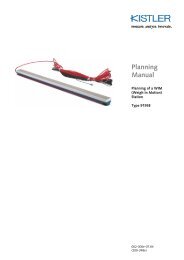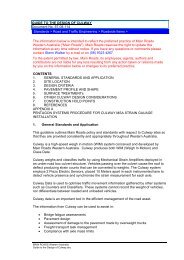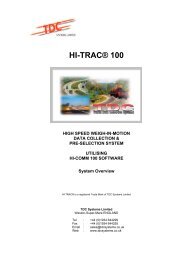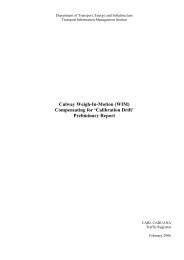AP-G84/04 Best practice in road use data collection, analysis ... - WIM
AP-G84/04 Best practice in road use data collection, analysis ... - WIM
AP-G84/04 Best practice in road use data collection, analysis ... - WIM
Create successful ePaper yourself
Turn your PDF publications into a flip-book with our unique Google optimized e-Paper software.
Accessed by AR - ARRB TRANSPORT RESEARCH on <strong>04</strong> Feb 2005<br />
TABLES<br />
Table 1 Use of axle sensors under different AADT values......................................................4<br />
Table 2 Current Aust<strong>road</strong>s vehicle classification systems (updated <strong>in</strong> 1994) .........................7<br />
Table 3 Vehicle classification systems currently <strong>in</strong> <strong>use</strong>...........................................................8<br />
Table 4 Vehicle classification systems by lengths...................................................................9<br />
Table 5 Accuracy requirements for <strong>in</strong>dividual sites ...............................................................17<br />
Table 6 Accuracy requirements for groups of <strong>road</strong>s .............................................................17<br />
Table 7 Examples of round<strong>in</strong>g AADT ....................................................................................18<br />
Table 8 Adjustment factors by jurisdictions ...........................................................................19<br />
Table 9 Some adjustment factors from short-term counts to AADT estimates......................20<br />
Table 10 Densities for traffic count<strong>in</strong>g stations........................................................................24<br />
Table 11 National highway traffic count<strong>in</strong>g station density by location and status..................24<br />
Table 12 Groups by functional classes: ..................................................................................26<br />
Table 13 Suggested volume stratification of <strong>road</strong> segments...................................................27<br />
Table 14 Suggested volume stratification based on % change <strong>in</strong> AADT ................................28<br />
Table 15 Complete list of <strong>data</strong> classes collected/computed and stored <strong>in</strong> Queensland .........31<br />
Table 16 Mean axle group and gross vehicle mass ................................................................35<br />
Table 17 RTA NSW rejection rules on classified counts .........................................................42<br />
Table18 High-speed Weigh-<strong>in</strong>-Motion Systems Used and available <strong>in</strong> Australia<br />
(source: Koniditsiotis 2000) ......................................................................................45<br />
Table 19 Accuracy requirements.............................................................................................48<br />
Table B1 Calculation of the Number of VKT Stations..............................................................53<br />
FIGURES<br />
Figure 1 A pair of pneumatic tubes and a vehicle classifier on a local <strong>road</strong> monitor<strong>in</strong>g<br />
two lanes of vehicle traffic and a bicycle path on the nearside of the photograph .....3<br />
Figure 2 Four positions of a two-axle vehicle pass<strong>in</strong>g over two axle sensors ..........................5<br />
Figure 3 Typical response of a loop detector crossed by a passenger car ..............................6<br />
Figure 4 Loop configurations for bicycle detection .................................................................10<br />
Figure 5 A sensor array for separate lane axle counts on a three-lane carriageway .............11<br />
Figure 6 Survey of <strong>road</strong> <strong>use</strong> <strong>data</strong> needs amongst Road Authorities ......................................15<br />
Figure 7 Expected percentage error for AADT from ADT and count duration<br />
(n-Day counts) for a 75% confidence level...............................................................18<br />
Figure 8 A design for traffic count<strong>in</strong>g program .......................................................................22<br />
Figure 9 An <strong>in</strong>tegrated <strong>road</strong> <strong>use</strong> <strong>data</strong>base from Queensland Ma<strong>in</strong> Roads.............................34<br />
Figure 10 Total mass of three-axle prime movers and three-axle semi-trailers.........................36<br />
Figure 11 Total mass of n<strong>in</strong>e-axle B-doubles ............................................................................37<br />
Figure 12 Laden and unladen vehicles <strong>in</strong> each vehicle class at Port Fremantle, WA ...............37<br />
Figure 13 Flow diagram of the CSIRO method for detection of corrupt traffic <strong>data</strong> ...................44<br />
Figure 14 Three axle masses of an articulated six-axle vehicle (Class 9) .................................47<br />
Figure 15 Adjustment factors for diurnal variation of CULWAY axle mass <strong>data</strong><br />
(Grundy et al. 2002) .................................................................................................47<br />
Figure 16 Adjustment factors for seasonal variation of CULWAY axle mass <strong>data</strong><br />
(Grundy et al 2002) ..................................................................................................47

















